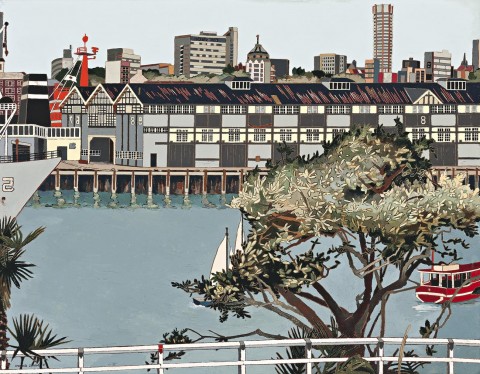WHARFS (WOOLLOOMOOLOO), 1984
CRESSIDA CAMPBELL
hand-painted and incised woodblock
60.5 x 78.0 cm
signed and dated lower left: Cressida Campbell 84
Mori Gallery, Sydney
Private collection
Philip Bacon Galleries, Brisbane
Private collection, Sydney, acquired from the above in 2008
Cressida Campbell: Woodblocks, Woodblock Prints and Paintings, Mori Gallery, Sydney, 12 – 30 March 1985, cat. 4 (as ‘Wharfs, 1985’)
Crayford, P., (ed.), The Woodblock Painting of Cressida Campbell, Public Pictures, Sydney, 2008, cat. W8503, p. 348 (as ‘Wharfs, 1985’)
‘One of the finest, most beautiful, vast and safe bays the sun had ever shone upon’ was what Joseph Conrad wrote of Sydney Harbour in 1906; and indeed, it is this natural beauty, and its intersection with human industry that provides a point of reference for a great deal of Cressida Campbell’s work. Views of Sydney Harbour form such an integral part of her oeuvre, that an entire chapter of her 2008 monograph was dedicated to their reproductions in print and on woodblocks – from Gore Bay, to Parsley Bay, Woolloomooloo and Walsh Bay, across over 30 years of sustained practice.
As it had done for Campbell’s predecessor Margaret Preston, Port Jackson (its tidal rivers, inlets and many bays) provides a constant and ever-changing source of inspiration to the artist, often appearing within her pictures as a ‘placid strip of blue fenced in by buildings and trees’.1 Placing great emphasis on observable reality, Campbell’s views record precious snapshots of Sydney at specific moments in time, although passed through the lens of Campbell’s assiduous design – space, depth and colour all gently manipulated to create a harmonious image. The view of Woolloomooloo’s Finger Wharf and its neighbouring buildings incised into this block of plywood is a beautiful example of this process, created at a time when the historic timber piled wharf had been marked for demolition.2 Its iconic gridded structure and three parallel gable roofs are still present, with renovated interiors now providing apartments for some of Sydney’s most famous residents.
Wharfs (Woolloomooloo), 1984, is one the earliest examples of harbourside views created by Campbell and is unique amongst her work. Not only was it painted in synthetic polymer paint instead of her habitual watercolour, but it is one of the very few woodblocks in Campbell’s oeuvre to exist entirely uniquely, without a related print. One of the peculiarities of Campbell’s adaptation of Japanese Ukiyo-e practice, and one that marks her as a decidedly contemporary artist in spite of her traditional subject matter, is her insistence on presenting the carved woodblocks with the same reverence as her prints. Wharfs (Woolloomooloo), was amongst the first blocks to be exhibited, in 1985 at her first show with Mori Gallery in Sydney in the company of other early coastal masterpieces such as Benny Gannon’s Bondi View, and Bondi Icebergs, 1984 (both held in private collections).
This work attests to Campbell’s prowess as a (Sydney) landscapist, it displays a quiet self-assuredness, refined detail and a careful, considered composition. Campbell possesses and transmits a rare skill in our age of immediacy and instant gratification – that of mindful attentiveness to the most minute and transitory of everyday details. By tightly cropping the the picture frame (sometimes even with a handsaw) Campbell accentuates the feeling of a snapshot, creating an off-centre composition including titillating allusions to what lies beyond our vision of sight. Campbell’s bold tendency to bisect and obscure her views with man-made structures such as poles and fences, or, more often, silhouetted native trees and bushes, is derived from centuries-old Ukiyo-e practices, which were also adopted by Margaret Preston. Here, the view of the harbour from the eastern edge of Mrs Macquarie’s chair, across the water of Woolloomooloo Bay is partially obstructed by a leafy banksia bush, its leaves rustling in the breeze. Campbell has somehow distilled in the grooves of this woodcut all the warmth, spontaneity, and calm relaxation of a Sydney afternoon.
1. McDonald, J., Cressida Campbell, Destination Sydney, Manly Art Gallery & Museum, Mosman Art Gallery, S.H. Ervin Gallery, Sydney, 2015, p. 108
2. a public outcry and Green Ban saved the wharf from demolition in 1991
LUCIE REEVES-SMITH
